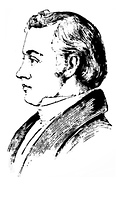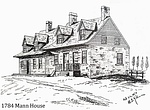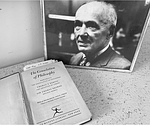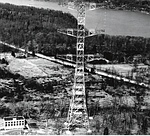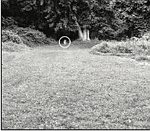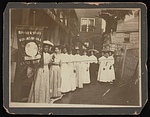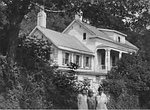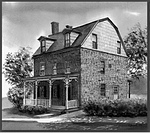A Short Overview of Palisades History
The recorded history of Palisades, NY begins in 1685, when Dr. George Lockhart bought 3410 acres of land along the west bank of the Hudson River. Two years later he sold the property to George Merritt, who soon afterwards built a house called Cheer Hall on the shore. In 1702 the population of the small settlement was 14 people, 8 of them slaves, living in two houses by the river. Read more »
Stories Behind the Stones - The Presbyterians
Started in 1863, the Palisades Presbyterian church has been a haven for justice and human dignity since its founding during the US Civil War. Two of its most influential leaders, Winthrop Gilman and Fay Hollingshead Ellison, are buried nearby in the Palisades Cemetery. This article tells their remarkable stories.
Read more...The Palisadian Inn
Ever wonder about the grassy field just south of the HNA Conference Center on 9W? Carol Baxter asked me whether I knew anything about the Palisadian Inn and sent a copy of an old postcard she came across with a building and gas pumps on Route 9W in Palisades.
Read more...Remembering the Palis–Agers
In the fall of 2007 a small group of older Palisadians, spearheaded by Herb and Jeannette Kellogg, began to meet to discuss ways of supporting each other as they aged. In January, 2008, the group sent out a questionnaire to everyone in the community aged 75 or older asking about problems they might be having and help they might need. Thirty–two (out of 58) questionnaires were returned and most of the responders said that they would be willing to attend a meeting to discuss the issue.
Read more...When Newspaper Gag Laws from the 1830s Touched Palisades
Nearly two hundred years ago, the Presbyterian minister, journalist and publisher Elijah P. Lovejoy briefly became the most famous white newspaperman to die for the abolitionist cause in America. This now largely forgotten incident, which occurred on November 7, 1837, in Alton, Illinois, electrified the nation during the 1830s and 1840s. A Princeton–educated publisher shot dead in cold blood by a pro–slavery mob caught the public's attention.
Read more...Planes, Trains and Automobiles
Over the centuries, Palisades attracted many to move here because of its bucolic rural setting. As newcomers settled in, they joined the community in protecting our hamlet. Some were good persuaders of the powers that be - other times, not so much. In sum, though, they have kept Palisades from becoming a completely different place.
Read more...Stories Behind the Stones – George Mann (1734-1806)
As a member of the Palisades Historical Committee, I am helping catalog a donation from the Mann family, prominent in Palisades history. More than 70 direct descendants of their patriarch, George Mann, are buried in our cemetery as well as scores more related through marriage: Lawrence, Gesner, Stansbury, Garrison, and Van Valen among them. At least one direct descendant still resides in Palisades.
Read more...Bob, Oscar and Me
Rockland is a magnet for people who work in the arts without getting sucked up into the Hamptons ethos. I have a special respect for a celebrity who has the means to live wherever they want but chooses to live among us.
Read more...THE STORIES BOOKS TELL US
The wall of bookshelves in my living room on Heyhoe Woods Road used to be filled with hundreds of scholarly works that belonged to my husband’s grandparents, Dr. Theodora Abel (PhD clinical psychologist) and Dr. Theodore Abel (professor of sociology). Most of these books haven’t been opened in fifty years.
During the counterculture 1970s, the Drs. Abel moved to Albuquerque and gave the house to their daughter Caroline and French son-in-law, Pierre Lalire. Pierre was a charming and hyperactive visual merchandiser for a string of prestigious department stores, including Lord & Taylor. He was also a prime instigator of the Snedens Landing “wine, women, and song” rat pack with Joe Hyde and Lee Savage, and not a big reader. Soon after he moved in, Pierre scanned the living room, pursed his lips, and declared the bookshelves “uuuugly.” His austerely imposing Polish father-in-law, and austerely imposing Vassar and Columbia-educated mother-in-law “deeed not have good taste.”
Read more...The Armstrong Tower
Although it is hard to miss, for most of us the tower isn’t more than just a familiar part of our landscape for as long as we can remember. Many of us can see it from at least one window in our house, especially at night. All of us have driven past it countless times. Standing at 425 feet above the top of one of the highest sections of the Palisades, the three-tiered Armstrong FM Tower in Alpine, New Jersey is unique in not just its appearance but also its history. Constructed in 1938 by Lamont Scientist Edwin Armstrong, the tower was the site of the first FM radio station in the world.
Read more...Palisades Cemetery – Stories Behind the Stones: Mike Evans
In the far northwest corner of the Palisades Cemetery, yards away from the closest grave, a sole headstone stands as if on guard. It is a military marker for Mike Evans, a World War I veteran. How he came to be buried there so isolated from the other graves is still a mystery but may speak volumes about the conditions of African Americans as they emerged from the Jim Crow South in the late 1800’s.
Read more...The Long Tradition of Rowing on the Hudson River
I fell in love with the sport of rowing over twenty years ago, when my friend and fellow Palisadian, Milbry Polk, invited me to come down to Piermont one afternoon and join a new club she had heard about. It was only six minutes away. Soon, I found myself wading out into the changing Hudson River tides six days a week to partake in an intoxicating fitness regime that offered fun and new friendships on an early morning schedule that fit in with working and raising young children. Almost a dozen Palisadians signed up when I did, all of us beginners, and we worked very hard to learn new skills without regular coaching, having to rely instead on guest instructors borrowed from nearby programs including the Merchant Marine Academy on Long Island, Norwalk and even Cincinnati. One year we spent an amazing week at rowing camp in Mexico City practicing in the old 1968 Olympic basin in Xochimilco.
Read more...Palisades Cemetery: Stories Behind the Stones
East of the old Palisades Country Store, down an unmarked lane, you can find the Palisades Cemetery. Hundreds of plots, most with weathered names, hold hidden stories of individuals who populated this town throughout its history. One such story, that of Makxim Krawchuk, at first blush seems a tale of woe, belying the idyllic setting where the gravestone stands sentry. But if you dig deeper, you can see beyond the struggles of this forgotten man to an inspiring story of human resilience in the face of unfair systems and prejudicial practices - a story right for our time.
Read more...Birch Brook Day Camp: An Oasis off Route 340
There is much controversy and consternation about the status of the 106-acre HNA property, formerly the IBM Conference Center, sandwiched between Routes 340 and 9W just south of Rockland Country Club, but long-time residents remember a time in the 1950s and 60s when the site was an idyllic setting for a summer camp.
Read more...Kwanzaa — What is it?
Each December the Outreach Program receives numerous inquiries about the festival Kwanzaa. This celebration is not a festival originating in any of the 55 African countries nor is it an “African” Christmas celebration. Kwanzaa is an African-American celebration of life from 26 December to 1 January.
Read more...The Unfinished Journey to Equal Suffrage
The fight for the passage of the 19th Amendment, which gave women the right to vote, took over 70 years. Leaders of the women’s rights movement, like Susan B. Anthony and Elizabeth Cady Stanton, devoted their lives to radically demand full citizenship in a country that had, since its founding, treated them as second-class citizens. They were revolutionaries, committed to abolishing a system that was designed to exclude them, imagining the possibility of building something new. Victory was unlikely.
Read more...Palisades Has Suffered Pandemics in the Past: When Cholera Came to Palisades and its Neighbors
Thanks to the 19th century diarist Nicholas Gesner we have a partial picture of the effects of three 19th century cholera epidemics that affected Palisades and Piermont. Nicholas lived in a house that is still standing on Closter Road, and at the time he wrote this entry he was 67 years old.
Read more...A Discovery in the Captain John House
In the spring of 2018, I was tasked with overseeing the restoration and rehabilitation of the Captain John House, an old and valued member of the Snedens Landing community in Palisades, New York. In 1916, Mary Lawrence Tonetti inherited the Captain John House along with most of the other houses that her mother had accumulated in the Landing over the years. Besides making these houses available–at very affordable rents–to an ever-changing cast of characters belonging to her vibrant New York City arts circle, Mary was a compulsive builder who loved adding amenities to her various properties. In the 1920s, she bestowed upon the Captain John House a stone “Ballroom.”
Read more...Restoration Update: Saving the John Green House
In 2015, one of Nyack’s oldest houses came close to being demolished. Situated just few doors from the river on Main Street, the three-story John Green house was in dreadful shape when a group of concerned locals stepped up and formed the John Green Preservation Coalition to save it. The group was able to convince the financial institution holding the deed to turn the foreclosed house over to them. They then started the arduous task of gathering funding to bring this important historical structure back to life.
Read more...Two Sneden Families or One?
Snedens Landing, the section of Palisades closest to the Hudson River, is named after the Sneden family that operated a ferry service across the river from the 1740s to the early 1900s. A 1745 map shows a house labeled “Snedens house the ferry” beside the Hudson River. This was Cheer Hall, built by William Merritt around 1700, and probably rented by Robert Sneden when the map was made. The ferry was originally operated by William Dobbs of Westchester. Robert Sneden married William’s step-sister Maria—called Molly—in 1731. He apparently helped his brother-in-law by taking on the Rockland end of the ferry business in the 1740s. The ferry business must have prospered; in 1752 Robert Sneden purchased Cheer Hall.
Read more...When The Cold War Came To Town
Orangeburg Control Base NY-03/04 wouldn’t stand out any more on a local map today than from1954 to 1974, but during that time it was one of the most crucial surface-to-air missile sites in a complex national air defense network, which included radar installations, civilian ground observers and command centers. Combined with sites in New Jersey, the network formed one of the largest defensive rings in the nation designed as a last chance to intercept Soviet bombers. The site was strategically placed at one of the highest points in the area and was armed with various types of missiles throughout its existence. Fortunately, the site was never put to the test.
Read more...



